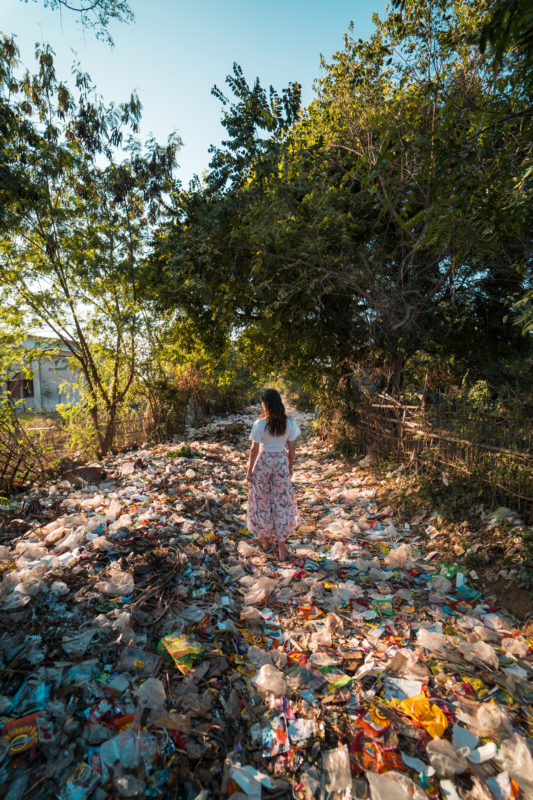Ksapa recently joined the World Circular Economy Forum led by Sitra, a Finnish Innovation Fund and supported by partners including the Finnish, Dutch and Canadian governments. Here are our highlights on the profound changes generated by Covid-19, that impact the very concept of circularity.
Covid-19 Has Generated A Surge In The Production and Recourse to Single-Use And Disposables
The issue of waste management is becoming increasingly controversial. In recent years, a number of organizations have committed to circularity, only to see these aspirations cut short by the Covid-19 pandemic. Instead, global mask sales have shot up from $800 million in 2019 to $166 billion in 2020. Lockdown measures and health restrictions further bolstered e-commerce and plastic packaging.
Many companies found the coronavirus highlighted not just limitations in their business models but also – and perhaps more importantly – development opportunities for greater resilience. In the fast-fashion and textile industries, closing manufacturing centers in China and South-East Asia drastically challenged global brands’ sourcing procedures. Tourism and the creative economy were severely impacted by travel restrictions. In the United Kingdom, Oxford Economics researchers estimate that some 350,000 jobs could be lost in the cultural sector alone. Conversely, companies that had integrated circularity in their resource management generally outperformed their counterparts regardless of the pandemic.
With these trends in mind, Ksapa recently took part in the World Circular Economy Forum, a global collaborative platform designed to engage the private sector and policy-makers alike on the issue of the circular economy. Here is our overview of how Covid-19 may be overcoming traditional bottlenecks to the circular transition and uncovering opportunities for sustainable value creation moving forward.
Misaligned political levers
A Disconnect From Territorial Realities And Specificities
While the regional circular economy initiatives demonstrate a clear commitment on the part of the public sector, results indicate proposals are disconnected from the reality on the ground.
As of October 2020, most G20 countries have developed fiscal stimulus packages to offset the adverse impacts of the Covid-19 pandemic. So far, Japan drafted the largest fiscal stimulus package as it amounts to 21.1% its GDP compared to the 4,3% in the European Union, 7% in China and 13,2% in the United States. That said, most packages focus on short-term crisis management, with Japan notably gearing to shoulder half of production facilities relocation costs but devoting just 0.02% of overall economic support to climate action. By contrast, South Korea issued a surprisingly ambitious $110 billion Green New Deal, complete with investments in renewables and a pledge to phase out coal and introduce a carbon tax. Though it plans to launch a Regional Energy Transition Centre to help workers transition towards more sustainable sectors, the $14.9 billion budget over 2 years will doubtfully cut it for this structurally carbon-based system.
Although certainly innovative and ambitious, such measures do not appear to take into account contrasting territorial specificities. Too often are stakeholders insufficiently involved in defining work priorities.
Challenges In Identifying And Engaging Relevant Stakeholders
Discussing and designing sustainable transition initiatives requires a systemic vision and therefore that reflections be as holistic as possible. A one-size-fits-all solution for circularity to mainstream is neither conceivable nor desirable – particularly at a time when stakeholders are asserting demands with greater force and specificity. For instance, the urgency dictated by the scale of the current health crisis and the lack of protective equipment stocks initially curtailed in-depth consideration of user experience and, until recently, the development of specific masks for the deaf and hard of hearing. In Belgium, adapted masks will not be subject to wholesale distribution: individuals have to make them at their own expense.
The Strategic Challenge Of A Circular Economy For The Benefit Of The Most Vulnerable
This underlines the extent to which the socio-economic and health impact of Covid-19 primarily affects vulnerable populations and increases disparities. Considering stakeholder specificities and territorial diversities as opportunities is in fact essential to develop sustainable and inclusive growth models. Indeed, as we face a second wave of the Covid-19 pandemic, the OECD predicted a 7.6% drop in global economic output in 2020. Unemployment rates in OECD countries could double from pre-pandemic levels, with little hope for recovery in 2021. Based on key learnings from past crises, we may expect the recovery to be comparatively slower in fragile economies, while the lowest incomes will not rebalance quickly, ultimately pointing to endemic and growing inequity.
In this scenario, encouraging a circular approach to aluminum packaging recovery, for instance, only makes sense if the collecting community has already invested in an efficient sorting infrastructure and identified a recycling channel. This tends to imply this type of operation will – at least initially – be contained to areas with considerable know-how and investment capacity. In times of a global pandemic, it implies disposable income on the part of pilot populations, which will not necessarily be the case for contamination hotspots.
While the recycling and reuse of Covid-19 protective masks are now on the table, the proposal faces serious questions as to consumer acceptability. In a comparatively affluent region, the population will tend to be older and prone to co-morbidities associated with Covid-19. As a result, they will be less likely to compromise their personal health to mitigate the impact of their masks on the environment and will probably fall back on short-term solutions such as collection bins for used protective equipment. However, it is precisely those areas with the capacity to test the effectiveness of circular concepts that need to be prioritized, to implement them at the speed and scale required by the gravity and long-lasting nature of our health crisis.
Solutions must imperatively be designed with accessibility and stakeholder relevance in mind. This can only be done by initially mapping key needs and opportunities in any given territory.
Lagging Mobilization From Financial and Business Players
Opportunistic financial players
In addition to expectations weighing on the public sector, financial players have generally been pushed to demonstrate greater granularity in non-financial performance. Investors have indeed come to identify the potential of the circular economy. According to the Ellen MacArthur Foundation, while they simply did not exist in 2017, as many as 10 public equity funds partially or wholly indexed on circular action were launched by industry leaders by in mid-2020. These include BlackRock, Credit Suisse and Goldman Sachs. In the last 18 months, at least 10 corporate bonds have likewise been issued to finance the circular economy, with the help of Barclays, BNP Paribas, HSBC, ING and Morgan Stanley among others.
Investors are looking for proactive players on the issue of circularity, as it is in increasingly synonymous of long-term resilience as well as massive opportunities. The electronics, automobile and mining industries are already facing limitations in the supply of raw materials, which has notably pushed companies to consider a circular approach to urban rare earth mining, among others applied to scrapped electronics. Thinking more broadly, the extraction of rare metals has become so contentious, circular models become all the more advantageous as key players pilot recovery systems operate in relatively constricted perimeters. Take polyethylene terephthalate (PET): once subject to major end-consumer acceptability issues despite its backing recycling infrastructure, profitability now hinges on addressing its volume shortage. Public and private decision-makers would do well to redirect resources accordingly.
Companies often lack circular ambition
While political and financial levers are gradually aligning to bolster the circular economy, the private sector has yet to meaningfully embed the concept across its growth models. Often players move forward on a strictly voluntary basis. The luxury industry, for example, relies on its capacity to offer rare products, historically switching from one commodity to another rather than sustaining their supply over time. Confronted with supply continuity and market disruption, circularity offers a once inconceivable development avenue. For others, the circular economy still appears to be an all too distant perspective – and a costly proposition at that.
Circularity programs have been initiated, but remain at a pilot stage and marred with low profitability. The PET recycling sector is indeed at first particularly capital-intensive, with revenues intrinsically tied to the Brent. As long as fossil fuels remain cheap, it will be more profitable to use virgin stocks than recycled materials. Companies could end up stuck between a literal rock and a hard place for a period of time. That could very well change given the adverse impact of Covid-19 on the energy sector. Until then, it remains essential to recover sufficient volumes to recycle with profitability indexed on a relatively high cost of oil. Only through mainstreaming circular processes and ensuring their democratization across the value chain may spin-offs successfully arise.
The circular economy as a value creation tool
For companies, investing in the circular economy is in fact both a profitable solution and – as made resoundingly clear by Covid-19 – a sound option for mitigating risks whilst increasing positive impact.
Business Models Are Bound To Rapidly Evolve – As Demonstrated By Covid-19 In A Matter of Weeks
The underpinning logic of our currently linear model may be summed up as follows: we consume natural resources we extract as well as energy to manufacture products that ultimately turn to waste. End story.
The pandemic has demonstrated the limitations of this conventional model, not least of which are price volatility, supply chain risks and disproportionate pressure on natural resources. The accumulation of these potential risks creates further uncertainty, discouraging investors seeking long-term resilience solutions. The economic arguments of structural losses and wastage are reason enough to question our material and energy usage. Turning these limitations on their heads, resilient circular models limit resource wastage and environmental impact by increasing efficiency throughout the product lifecycle.
Inspiring efforts also demonstrate circularity’s significant impact on cashflow. As companies bear the brunt of the Covid-19 crisis, some turn to a seldom-used source of revenue: industrial waste and unsold products.
Well-documented examples demonstrate the power of the circular concept to boost transformations and rekindle competitiveness
An American consumer goods multinational cut costs by 1.8 billion euros by setting up an innovative solutions team to transform industrial and unsold waste. Dutch hospitals worked with a medical equipment specialist to locally recondition scanners and tomodensimeters, both instrumental in dealing with Covid-19. This approach allowed staff to reduce expenses and improve service quality. Since it was conducted in Best as a short-circuit operation, reconditioning only took 2 weeks instead of the regular 6 to obtain such qualitative products. Faced with a shortage of ventilators to manage patients with respiratory failure at the heart of the pandemic, California approached fuel cell manufacturer Bloom Energy to refurbish hundreds of used ventilators in storage. Often of high value, these products do not go through traditional sales channels and often end up incinerated or buried. Similarly, no recovery – let alone recycling – channels were set up to manage the accumulation of used protective masks during the first wave of the pandemic. As France approaches the second with more structure, discussions have emerged on optimizing the reuse of otherwise discarded polypropylene. Innovative technological platforms would notably help establish direct contact with potential end-users.
While the concept of turning this waste into a resource is far from having reached full potential, the crisis may have spurred a few small businesses to leapfrog. Improving material productivity is particularly critical for manufacturing companies in the European Union, as they spend almost half of their budget on purchasing raw materials. The circular economy could very well improve their profitability and protect them from increasingly fluctuating commodity prices. Speaking at the WCEF, the SCG Group in Thailand stressed how Covid-19 presented the group with an opportunity to reflect on integrating circularity in their business model, starting with more investment in R&D. As one of the most carbon-intensive industries, construction presents inherent challenges to adopting circularity approaches, but stands to gain the most. Among the more mature solutions, the implementation of a detailed simulation of the construction stages could significantly reduce construction waste, eventually cutting both project costs and carbon footprint.
According to a 2015 European Commission report, the circular economy would save European companies up to 600 billion euros – that is, 8% of their annual revenue – while reducing their annual GHG emissions by 2 to 4%. Embedding circularity into business models therefore stands to allow companies to curb their risk exposure in the short and long-term. Mapping value chains more often than not shows how globalized they have become because of cost-cutting and avoidance of overly-restrictive environmental standards. As a result, a cotton T-shirt is allowed to travel from a production site in Lubbock (USA) to bale loading in Los Angeles, for spinning way be carried out in Shanghai, printing in Miami… only to be sold in New York or Paris. Once used, it may be shipped to Tanzania and sold on a second-hand market in Nairobi. The crisis has demonstrated how extending the supply chain, while seemingly cheaper, only makes material sourcing more unstable and prone to disruptions inflicted by the global conjuncture. A prime example lies in how plant closures in China, combined with trade restrictions, brought the world close to a standstill.
A likely correlation between increased circularity and effective decarbonization
More than 100 billion tons of raw materials are extracted each year to meet various needs. Before long, companies will have no choice but to ensure their supply chains are more resilient, better distributed and use more recycled materials and components… if only to reduce their organizational carbon footprint.
While more and more companies turn to carbon compensation – through voluntary offsetting platforms such as ClimateSeed and VCS/GoldStandard – circularity offers solutions to address climate change more structurally. Implementing shorter distribution loops to sell consumables, prioritizing recycled materials and renewable energies, using digital technology to evaluate potential losses in the construction sector… all these circular approaches help significantly reduce the carbon footprint of these organizations and promote the circular economy as a sustainable model. Given emission trading schemes for industrial emitters, carbon taxes and other financial mechanisms are on the rise, setting up a circular strategy is that much more important to safeguarding corporate resilience in the face of the turbulence to come.
Conclusion: Circularity, a solution for resilience
Covid-19 has presented key economic players with an opportunity to review their business models. We collectively stand at a turning point, where technological and societal levers allow for the development of circular models on a large scale. We can still see to it that the global economy remains efficient, provided we fully decorrelate economic development and resource consumption. The Ellen MacArthur Foundation, SUN and McKinsey stresses that through circularity, Europe could take advantage of the impending technological revolution and generate a net profit of 1,800 billion euros by 2030 – 900 billion euros more than by following its currently linear development pathway.
The circular economy could create major opportunities ranging from market renewal, value proposition regeneration and industrial innovation. Territorial realities and specificities determine the relevance of we systems we create. Consider how circularity is so inspiringly intrinsic to African and Asia-Pacific cultures. Rethinking models based on what is readily-available is fundamental to developing adapted solutions and ultimately enacting inclusive growth strategies for all peoples and territories. As we ponder innovation and digital technology’s contributions to responsible development, we can also ensure the resulting solutions actually answer the needs and demands of various societies.
Sona is a Consultant for the Advise team at Ksapa.
She graduate in international development from Sciences Po Paris, and has worked on sustainable models within a diverse number of industries. Previously based in Kuala Lumpur, Sona has also tackled social and societal issues for Total and the Galeries Lafayette Group and has analyzed the implementation of the Chinese carbon market from Beijing. Her experience in different markets have helped her use a global approach when building a sustainable performance.





